Epomaker TH80-X Review: TH is for Thocky
retail price: $99.99
Disclaimer: Epomaker sent us a unit of the TH80-X free of charge to review, but all thoughts and opinions expressed in this review are our own and were not discussed with the company prior to publishing.
We are a participant in the Amazon Services LLC Associates Program, an affiliate advertising program designed to provide a means for us to earn fees and support our channel by linking to Amazon.com and affiliated sites.
We’ve all seen the videos of thocky keyboards on YouTube. Oftentimes, they are custom builds. Up until now, all of the keyboards I have tried for The Sypnotix, while being pleasant to type on, were never very thocky. They could not come close to those viral custom builds. That changes today: The Epomaker TH80-X is certified thocky! Though I live for the thock, there’s more to a keyboard than the way it sounds, especially when the MSRP is $100. In this review, I’ll be discussing the features of this board that shine and those that disappoint.
Epomaker sent us the TH80-X in the grey green color with wisteria linear switches.
The design behind the thock
I’ve already stated in my intro that this board is satisfyingly thocky, which immediately won it huge points from me as I adore how it sounds to type on. However, there are some other aspects of the typing experience that are worth discussing.
First of all, this board uses Epomaker’s wisteria switches. These particular switches are linear and meant to provide a “smooth” typing experience. It is definitely smooth, but I do feel it might be too smooth for some people’s liking. These switches have basically no tactile feedback. If you like to feel a bit of resistance when you type, this is not the board for you. It is worth noting that the switches are hot-swappable, so if you did decide you dislike the wisteria switches, you could easily get something more suitable from Epomaker’s website. They also sell the TH80-X model with black, yellow, and flamingo switches.
As for the keycaps themselves, they are your average slightly-textured plastic feel, so I don’t have much to say about them in that regard. The keycaps that come with the board are ABS plastic, which is always a bit disappointing, but the Epomaker website has boatloads of adorable keycap sets to choose from, many of which are made of the more durable PBT material. Another thing I dislike about the keys is that the legends are printed on in black, which means the RGB lights do not shine through the key legends.
the rgb is just ok
We all appreciate a keyboard with RGB, but not all RGB is created equally. This board’s RGB is, unfortunately, underwhelming. The main reason I say this is because the RGB is not reliably true to color and is not capable of pastels. You try to do a pastel shade and you just get white; you try to do hot pink, and you get purple; you try to do yellow, and you get green. I normally see such lackluster RGB on cheaper boards, and you can absolutely do better for $100 (some Razer and Corsair models are in this price range and have better quality RGB and better customization options).
The board also has minimal RGB customization: all you get to do is pick a preset and pick a color for that preset. If you want to be more creative, you can go key by key and choose a color for each key, but then you have to settle for static lighting. The presets aren’t great, either. There are a handful of them that do look nice, but I would argue that the “rainbow” colors on this board are kind of ugly. The rainbow wave is nice, but any effect that has multicolors that aren’t blocked off in sections and are instead kind of random does not look very nice because the colors just don’t go that well together.
The software for adjusting the lights has a tab where you can download color stories created by other Epomaker keyboard owners, which is a nice feature for those who want a nice RGB setup but aren’t interested in creating one themselves. However, if the model of the creator’s board doesn’t match your own, the RGB won’t always look right.
Speaking of the software, it is unacceptably clunky when choosing custom colors. Every time you move the marker on the color scale, the whole scale has to reload. This makes it time-consuming to pick your perfect color. It is literally easier to just use Google’s color picker to get a hex code. Luckily, you can copy and paste hex codes into the Epomaker software.
this keyboard has a screen?!
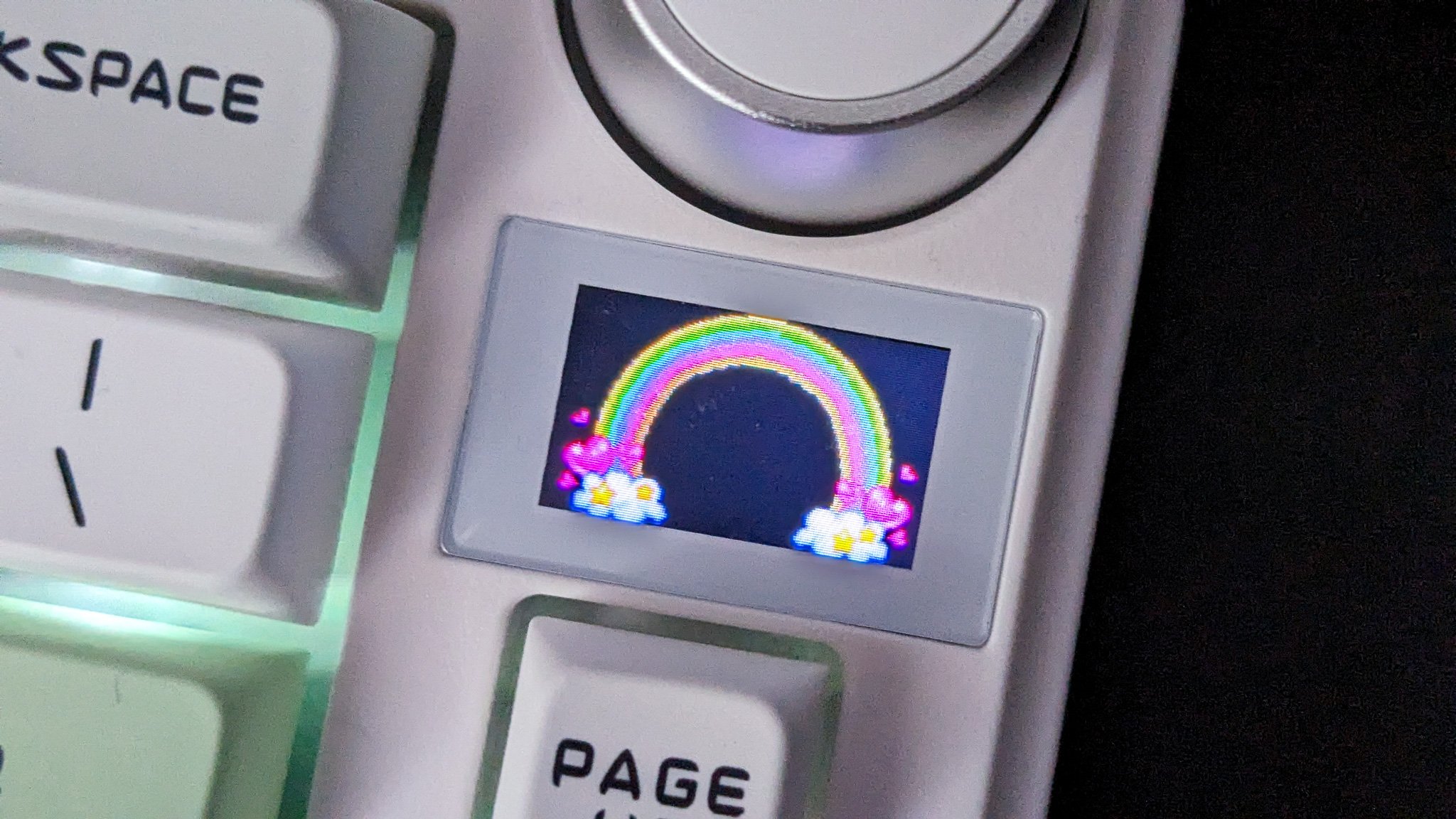
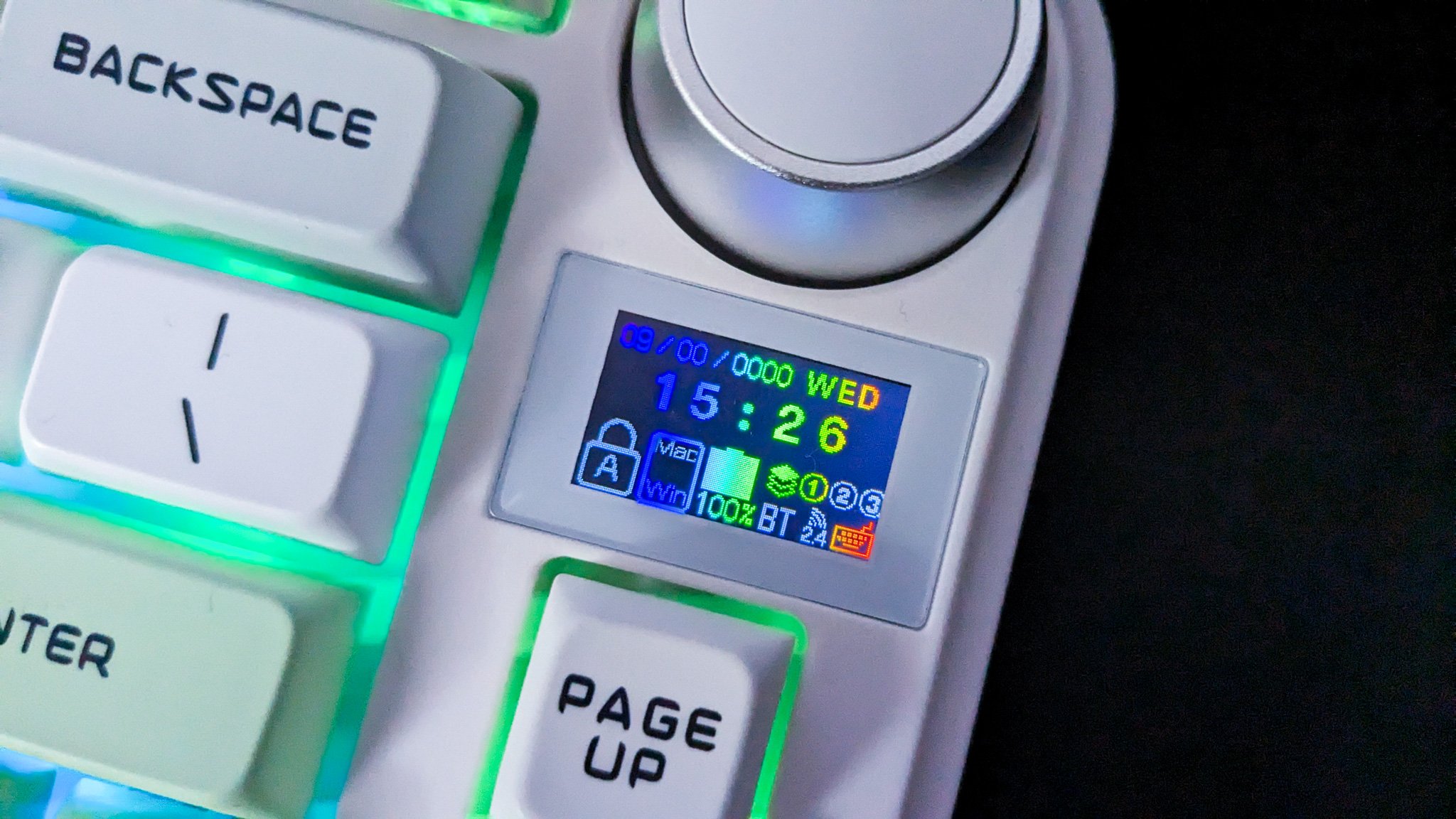
When I saw that this keyboard had a screen, I was wondering what it was for. The screen mainly displays certain settings like the date and time, whether you’re on Windows or Mac settings, what profile you’re on, the battery life, and whether you’re on wired or wireless mode.
It also helps you adjust the settings of the board without opening the PC application. However, I would argue that the software is still somewhat of a necessity. The screen has the capability of displaying a photo or gif (which is honestly so cute and fun), but you need the software to upload it. You also need the software to set the time.
I would love the date and time setting if it actually worked properly. The time does work, but it is in military timing, so it isn’t super useful to me as an American. I cannot get the date to work at all. In the software, it’s easy to find the button you need to press that’s supposed to adjust the date and time, but while it will set the time, it always resets the date to 0/00/0000. I also do not see a way to adjust the date or time via the settings menu on the keyboard itself.
I would have found a lot of value in the screen if the date worked and if the time was displayed as 12-hour rather than 24-hour. Since it doesn’t work that way, it does feel a bit unnecessary. However, I genuinely do love being able to put a photo or gif on the screen, so it is overall a cool feature that is also pretty unique.
wired and wireless!
Something that gives this board a lot of value is the fact that it can be used wired or wirelessly. There are many people who have both a PC and a console, so being able to use one keyboard for both is quite convenient. Plus, this keyboard has a USB-C cable that detaches from the keyboard itself, so if you want to use it wirelessly, you do not have to go through the hassle of detaching it from the back of a desktop PC.
The Epomaker website lists the battery as 4000mAh, but what does that mean? Well, if you leave the keyboard on wireless mode and never turn it off (it has a switch that allows you to turn it off when not in use) then it’ll last roughly two days. Of course, this could be more or less depending on how much you use the board.
I work on my PC and I also enjoy gaming, so I do spend at least 8 hours a day on the computer, if not more. However, the board does conserve energy by turning off the lights whenever it is not in use. I’m not sure what the exact timer is, but I wouldn't be surprised if the lights turned off within a minute of idleness, as I noticed it didn’t take long for the lights to go out. So, if you’re just sitting at your desk watching YouTube, the keyboard is using less energy than if you are actively gaming or typing something up for work.
I think the battery life is pretty fair and would obviously be a lot better if you simply kept it turned off or plugged in when not using it wirelessly. Also, this keyboard can be connected to your PC via Bluetooth or wifi.
One last thing about the wireless mode – I connected via Bluetooth, and I was pleasantly surprised by how responsive the board still was. I assumed that whenever the lights had gone off, the board may need a moment before it got to working again, but that wasn’t really the case. Oftentimes, even when the board was idle, whatever key I pressed would still get fired. There were only a couple of times where I would type something while the board was idle and the first letter of the sentence was missing. Other than that, the board did take a little longer to wake up a sleeping PC while in wireless mode than in wired mode.
qualitty issue or justt a bad swittch?
The T key in particular would fire twice about 90% of the time when I pressed it.
About two weeks into my testing of this board, I came across an issue that would have been rather serious if I hadn’t been able to fix it. The T key in particular would fire twice about 90% of the time when I pressed it. This may not initially seem like a big deal, but it got to be rather annoying. Having to constantly go back and erase one of the extra Ts was incredibly inconvenient. Since I work as a writer, this was also the sort of thing that would add extra time to my work because, unfortunately, spell checks and Grammarly do not automatically correct the mistake every time. In gaming, this could certainly be an issue as well if you use T as a hotkey for anything.
Luckily, I was able to fix this problem myself. It is pretty common for mechanical keyboards to include a few extra switches, especially if the board is hot-swappable. So, I removed the switch under the T key and replaced it with one of the extras. That seems to have solved the issue.
However, I am honestly not fully convinced that this won’t happen again or that it never happens with other keys. Sometimes, I think the spacebar also fires twice, but it’s not happening frequently enough for me to replace the switch. I’ve also noticed P fire twice, comma fire twice, i fire twice, and D fire twice. I have to wonder if the lack of resistance when typing causes this because it’s almost too easy to depress the keys. It could also be that the wisteria switches are poor quality, or that I am unlucky and got a slightly defective board.
The other thing that is strange is that the board worked perfectly for about 10-12 days before the issue began to happen. I did not spill anything on the board, I didn’t drop it, and I don’t feel that I am that harsh of a typer, either (and even if I were, shouldn’t keyboards be made to withstand the force of a true keyboard warrior?). It’s just odd to me that it worked for a while then suddenly got janky. Until that happened, I liked this board enough that I was considering buying some adorable keycaps for it. Now, I’m not sure it’s worth it. I’ll certainly be waiting a few months to see if any other key firing issues occur before I put money into this.
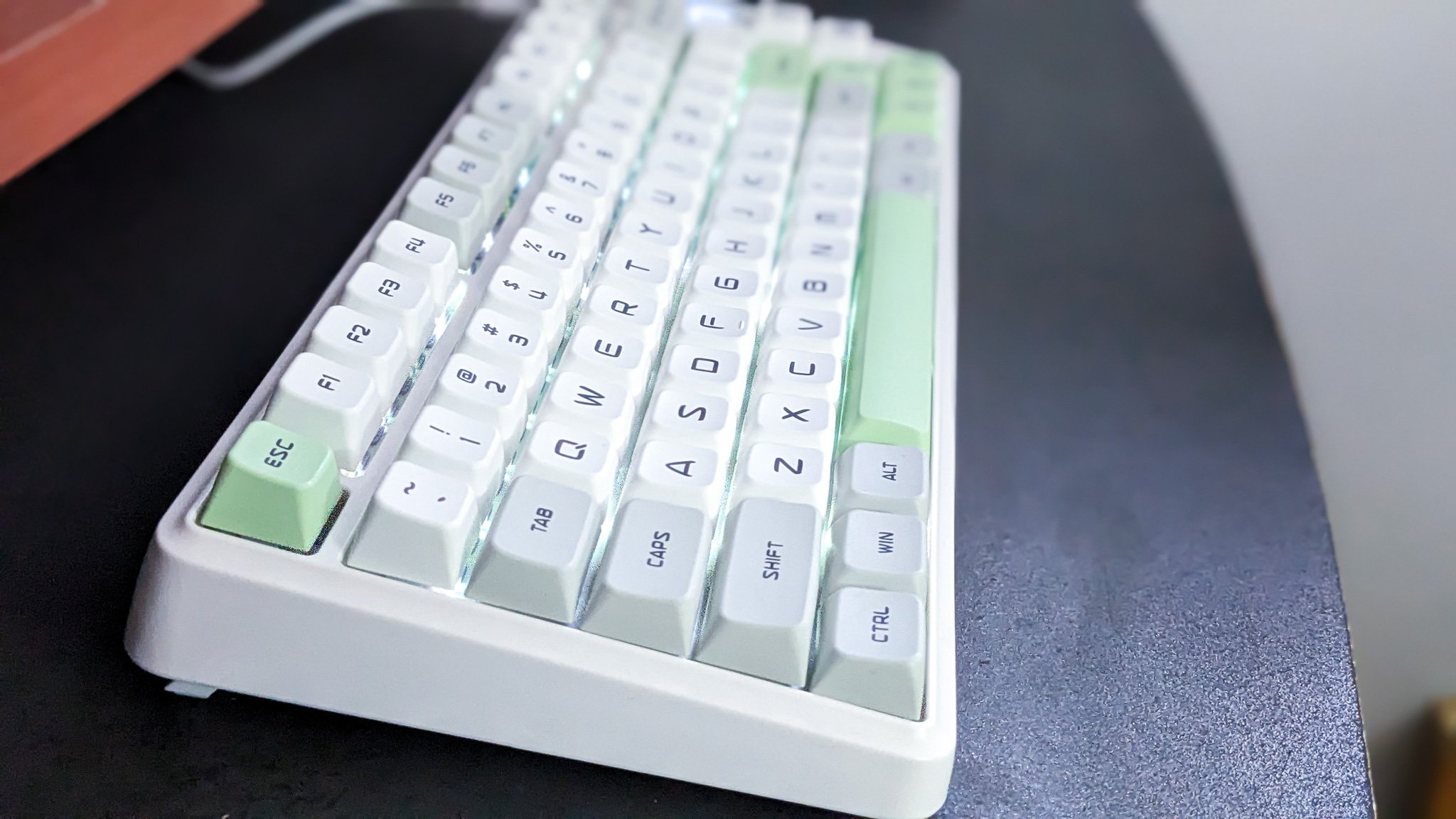
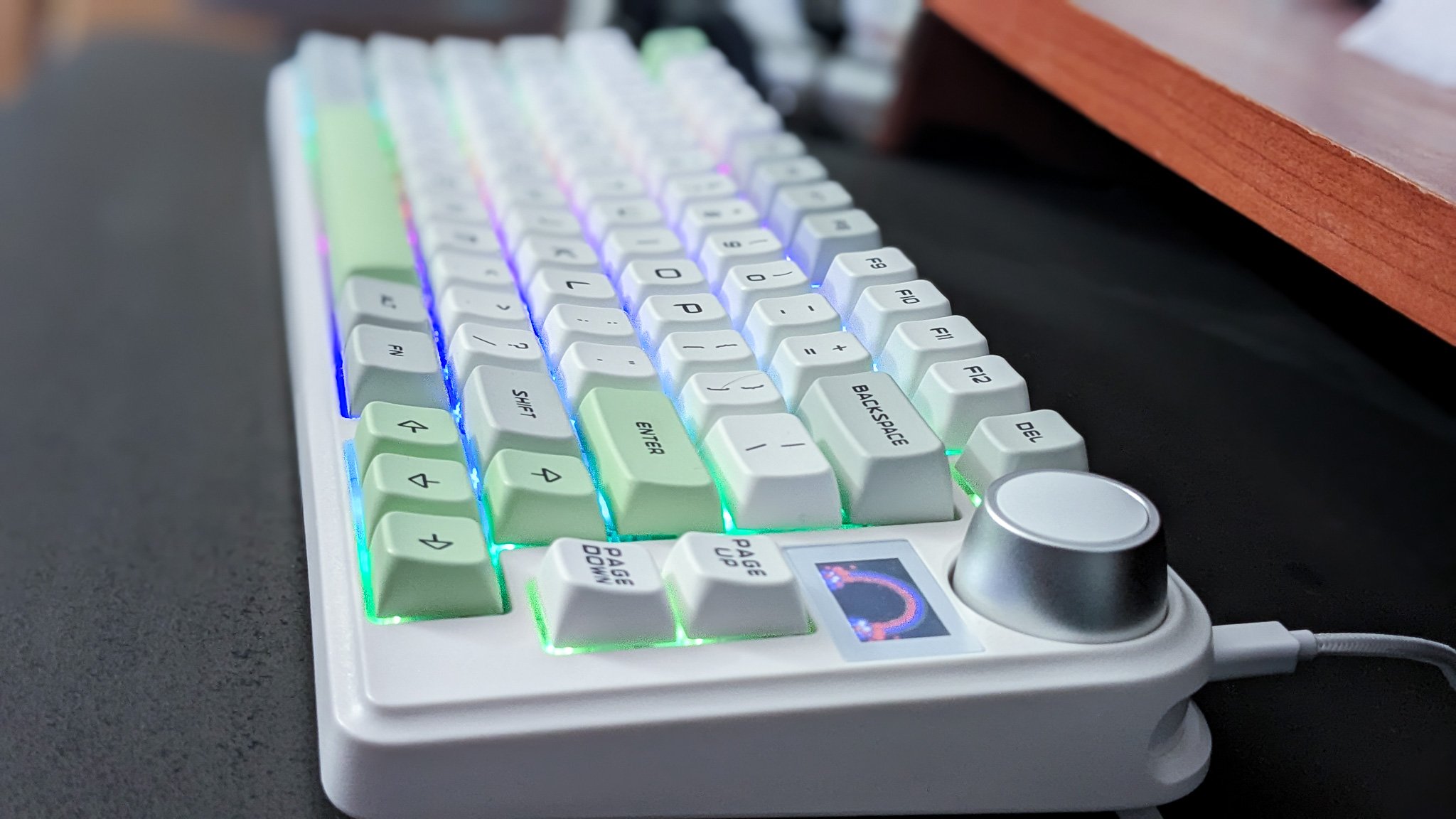

but does it game?
This board has all of the bells and whistles you would expect from a gaming keyboard. It has macro capabilities and three on-board profiles. It is 75% size and it kept the function keys, which gamers may appreciate. Although I have gotten used to gaming without the function keys, I do like to have them because they are great for commands that I don’t use as often but still want to have on a hotkey. For example, F12 is the default screenshot key for Steam, so it is nice to not have to remap that.
Despite the weird issue I had with the T overfiring, I haven’t had any notable issues while gaming with this board. I keep it wired while gaming, but I do feel the wireless mode is responsive enough that it would likely be fine for most games. Of course, a wired connection is always going to be faster than a wireless one, so just keep that in mind.
final thoughts
Though I was super excited and enamored by the thockyness of this keyboard when I first started using it, my thoughts on it now are that it is just okay. A lot of its cool features fall a bit short, and it has a few too many flaws for me to feel that it is fully worth $100, or even $80 when it’s on sale. For example, the screen is a neat feature, but it doesn’t display the date properly and the time is military. The board has RGB, but it is lackluster and not true to color. Though I managed to fix the issue with the T firing twice, I am not convinced that the board as a whole doesn’t have the tendency to occasionally double fire other keys. I wish I could love the TH80-X because it truly is a joy to experience the thocky typing, but the thock alone is not enough to make up for this board’s flaws.



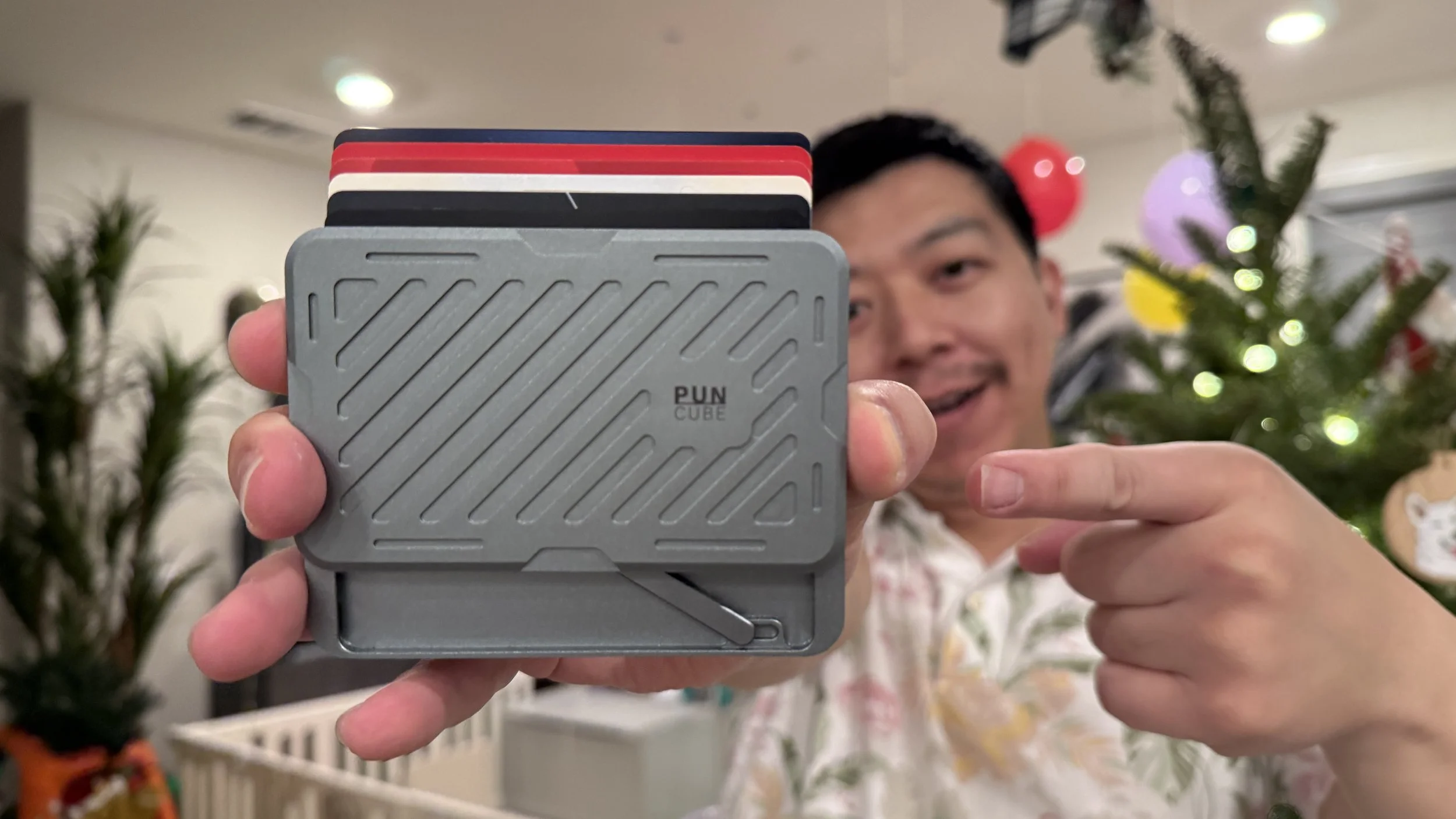







Seri
A writer by day and gamer by night, Seri’s most prized possession is her computer. In fact, she built her desktop PC herself and repaired her college laptop with nothing but Google, Reddit, and determination to guide her. This do-it-yourself attitude was born from frugalness, so if you see Seri raving about something, it’s probably worth the price.